
The Darksiders series is back with its first spin-off title: the co-op focused, gun-toting Darksiders Genesis. Developed by fledgling studio Airship Syndicate (founded by veteran Marvel Comics creator and game developer Joe Madureira), Genesis takes place years before the original trilogy and acts as a prequel to the series’ main entries. While early descriptions billed the game as “a Diablo-style action RPG”, the game offers a bit more action and a lot less RPG than that description suggests. The game’s producer, THQ Nordic, calls it a “gun-slinging”, “top-down action adventure game”, and we’re apt to agree. Darksiders Genesis sticks to its hack-and-slash roots even as it traverses the boundaries between genre and time.
Darksiders Genesis
Developer: Airship Syndicate
Producer: THQ Nordic
Platforms: Windows PC (Reviewed), Playstation 4, Xbox One, Switch, Stadia
Release Date: December 10th, 2019 (PC, Stadia), February 2020 (PS4, Xbox One, Switch)
Players: 1-2
Price: $29.99
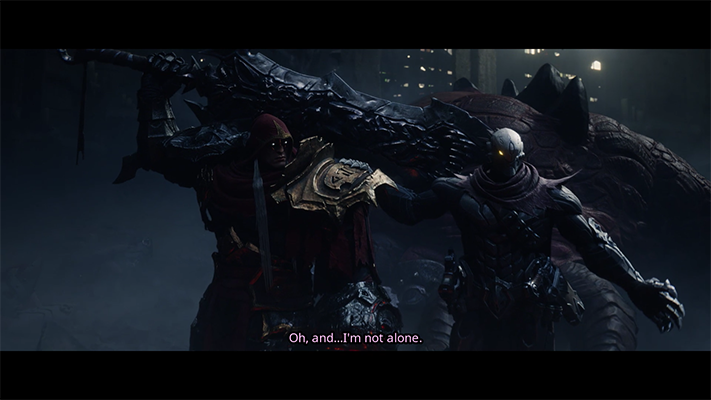
Darksiders Genesis can be played alone, but it’s begging–and designed–to be played with a friend. If we’re being honest, co-op is where the game shines. With that in mind, we decided to try something a little different ourselves.
You have two reviewers with you today, and this review–from here on out–is comprised of both of our interlocking reviews presented in lockstep.
Each section will be marked by its author so you can better keep track of the conversation. That said, let’s take this once more, from the top.

Staff2: After nearly a decade, the Darksiders franchise and story reach their fourth installment, Darksiders Genesis. A prequel, the game tells the story of the events leading up to the eventual war-on-Earth, from later titles, and the [spoiler alert?] council’s inevitable betrayal.
The game begins with an empty consolation by The Council, for the genocide of your people, which you were ordered to commit with your own hands (prior to the start of the game).
Two of the Four Horsemen of the Apocalypse, Strife and War, are sent to hell to deal with a plot of demons conspiring with Lucifer to gain more power. The player will shoot thousands of nameless demons in the name of the council, sans questions.
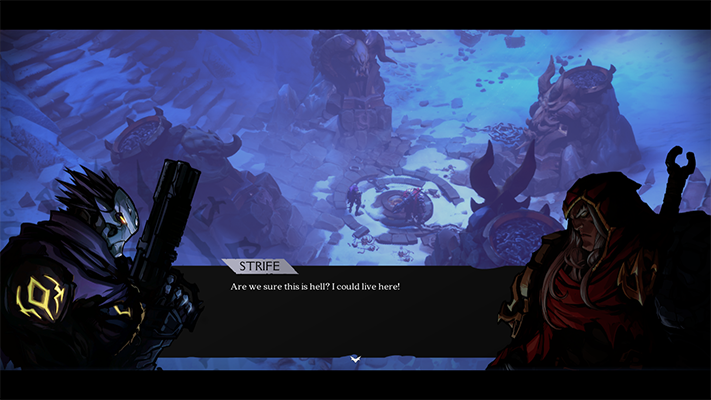
Staff1: Believe it or not, Hell is actually a really cool place. [Ha. Haha. Kill me.]
The game uses, as much as can be observed, all new assets created uniquely for Genesis and its unique perspective.
The art design supporting those assets is pleasantly smooth, as if painted with slightly washed watercolors. The art behind the cutscenes (specifically the 2D animated ones, though they also come in 3D modeled form) are conversely emboldened by their high-contrast linework.
There is a bit to be appreciated in terms of level design (with each new level being accessible via a “hub world”). The levels are, periodically, visually-or-artistically interesting, though often feel chasmous.

Staff2: Problem is, the level design is just as often bland, empty, and uninteresting. There is relatively very little to interact with, save the tool-based “switches” and puzzles.
A box or crate here, a barrel there; just random breakable junk littering otherwise generic caves.
When it wasn’t a cave that looks painfully randomly generated, its large empty spaces devoid of anything notable.
Staff1: Part of that is because of the genre switch. The game tries to make room for the new protagonist’s ranged combat, but that extra space often comes off empty and disjarringly oversized.
Like two kids in a trench-coat, the levels are, at times, visually misshapen.
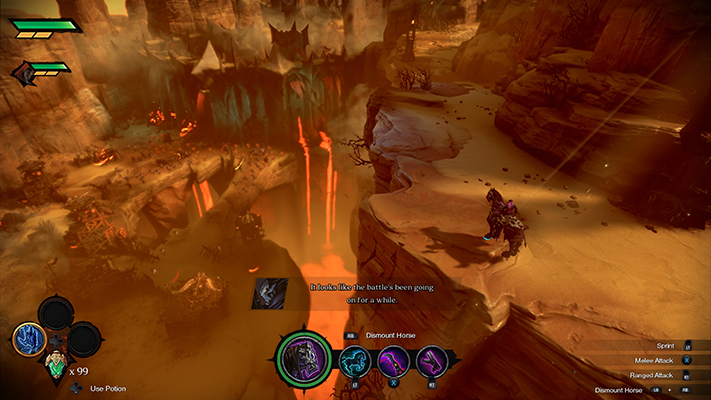
Staff2: Here’s the thing: I’m not so sure the “genre switch” ever really happened. Darksiders Genesis is just more of the same but from a different camera angle.
From the “use the right tool” puzzles, to the platforming, to the button-smashing, auto-combo-action combat: It’s all just more Darksiders.
That’s not a complaint, per se, but clinging to those game mechanics feels weird. Outside of the 3rd-person, over-the-shoulder action genre they were built for, I’m not sure it works as well.
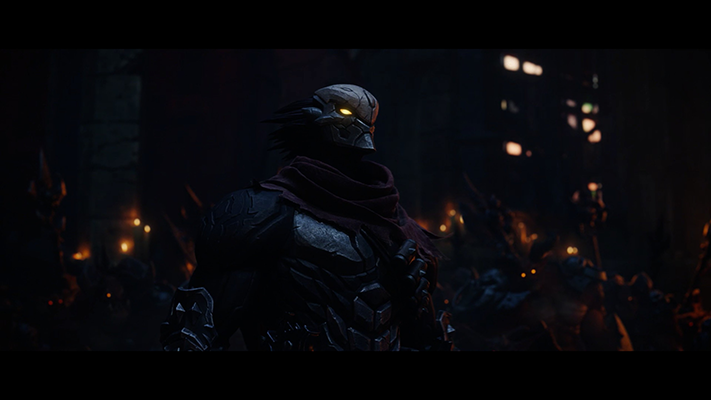
Staff1: Darksiders Genesis really does want to break the mold–to try something new, but rather than fail, it just never fully commits.
Despite featuring a new protagonist, shifting into a new genre (or really, a different-if-not-novel perspective on the action-adventure genre), and introducing a heavy focus on two-player cooperative play, the game ultimately feels very… well, like Darksiders.
Then again, the Darksiders franchise is beloved for a reason, and the odd synergy of old-and-new is welcomed. It’s just that, when you commit to the new, the old can suddenly feel quite antiquated.
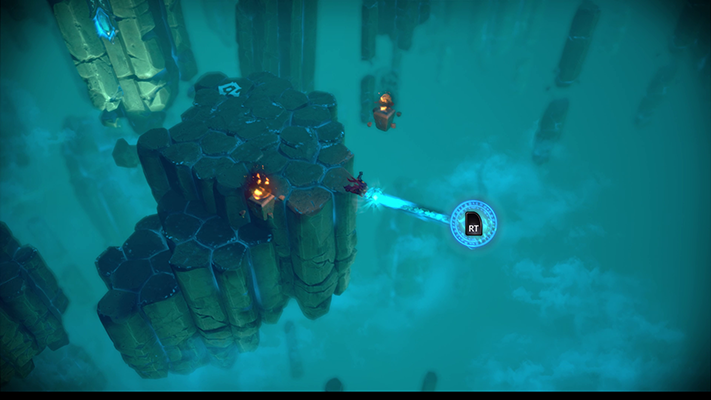
Staff2: It’s not that it’s not a fun game, but the shift seems shoehorned. Ultimately, it doesn’t work well with certain aspects of the game.
Consider the dodging, which has a significant delay after each dodge. It works well for Strife because he’s ranged; when he dodges, he has time to react to what’s happening.
War, on the other hand, he’s already in the fray. Most enemies don’t have “tells” that broadcast their next attack, and War just can’t get away fast enough to not eat dirt.
The moment I started to look at it as a Darksiders game, rather than the “Diablo-style, looter, action-RPG” it was being marketed as, was the moment I started having at least the semblance of fun.

Staff2: Another thing is the camera. It just doesn’t fit.
Staff1: One of the first things I said when we picked the game up is, “Isometric cameras have no place in a platforming game.” I stand by that.
The isometric view prevents functional depth perception, which in turn makes it hard to isolate where your character is in three dimensions simultaneously. It’s way too easy to find yourself floating off the wrong direction.
This can get much worse when you start to lose screen real estate, such as in local, split-screen co-op or the game-breaking zoom automatically applied to ultrawide resolutions.
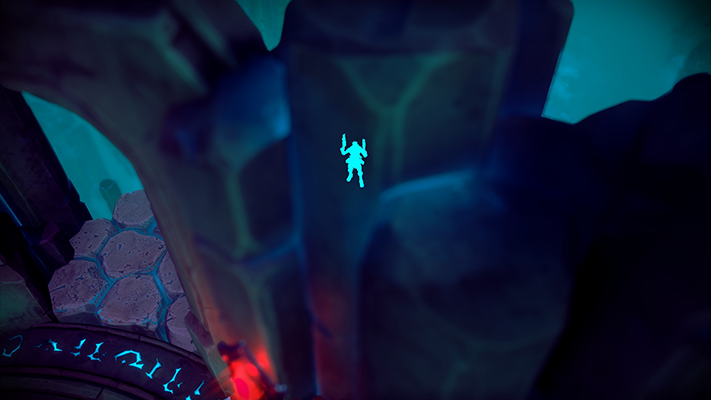
Staff2: Walls and floors also blend into each other, and the absence of any other markers makes judging depth (or where a platform or item is) nearly impossible at times.
Other times what you need to find, or where you need to go is completely obscured by a foreground wall.
Even though your character receives an outline to define where they are behind the obstruction, everything else, including the enemies trying to murder you, become invisible.

Staff1: Other than the camera occlusion, the game has other obvious technical issues that range from irrelevant to game-breaking. Monsters glitching through walls or floating in the air, for example.
Strife and War got stuck inside of random walls over a dozen times throughout the game. The first time it happened, we had to reset the game.
A pre-launch patch “fixed” the problem by killing-and-respawning you should you get stuck, but even this can result in lost progress.
Staff2: At another point, a torch refused to light no matter what we did. We were stuck there for 30-minutes with no way to move forward in the level.
Some of these problems will likely be patched in the coming days, but until they are, it bears mentioning that there is the possibility of you experiencing them as well.
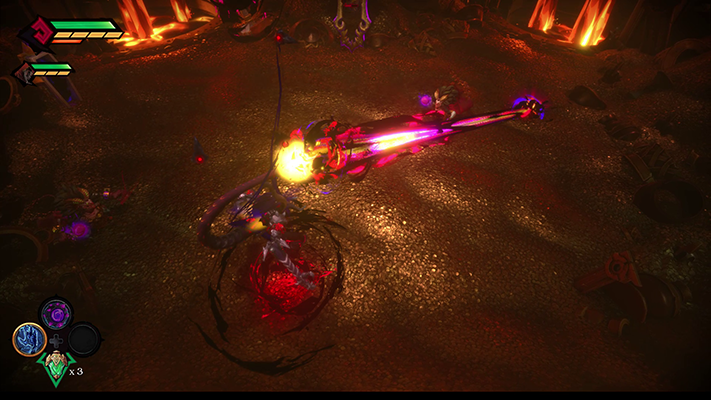
Staff1: You can switch characters throughout the game by pressing LB + A. You can also do this in co-op, but you’ll need to have both players nearby.
It’s a welcome feature that lets both players experience both characters.
Staff2: Gunning down demons with Strife is fun, and gives you a real sense of how powerful he is.
Overpowered, in fact. His chain-lightning easily lays waste to most enemies on screen in mere moments. Unfortunately, War simply can’t compete in terms of DPS, avoiding damage, or combat options.
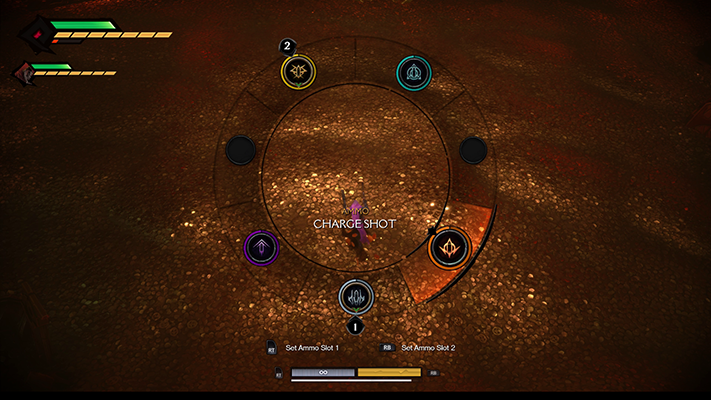
Staff1: Strife is clearly the more versatile character, due in large part to his ranged attacks and paired ability to switch ammunition mid-combat. You can bring up a radial menu with LB + RS that lets you switch both your primary and secondary ammo on the fly.
Staff2: Both of them, however, can be torn to shreds at the drop of a hat the moment any large or unique enemy spawns. Dying in one hit despite having a full life bar is not out of the question.
In co-op, you have time for a friend to resurrect you, but this often starts a vicious cycle of death-and-respawn that is hard to break (being resurrected with a scant 50% of your already insufficient HP).
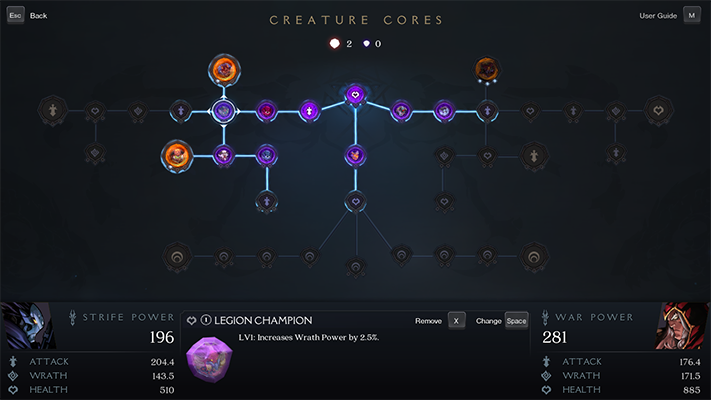
Staff1: There is some relief available in the form of character upgrades by way of the “creature core” system. Throughout Darksiders Genesis you’ll collect these cores from slain monsters or purchase them from NPCs in the level-hub.
Once you’ve acquired the cores, you’ll slot them into a core-grid to receive that core’s power-up. Each slot in the grid accepts a predefined type or level of core, so it’s not a complete free-for-all.
Staff2: These creature cores make for the only real “loot” found in the game, save for the predefined character abilities you’ll find along the way and the numerous types of currency used to buy power ups (thrown at you in such quantity the whole upgrade system ultimately seems reductive).
No matter the amount of upgrades, the combat remains relatively elementary and there is very little room for character building. Everyone who plays Genesis will play roughly the same way.

Staff1: You can offset the game’s difficulty by grinding away for upgrades, but the relatively simple combat that facilitates that grind can become a bit dull over time.
It’s not enough to throw down the controller, mind you, but the burden becomes a lot easier to shoulder with a friend.
This is what I mean when I say the game is begging to be played co-op. As a solo adventure, it’s just lacking; in story, in combat, and in general. As a co-op dungeon crawling adventure, it can be a load of fun that totally justifies the ultra-affordable price-tag.

Staff2: Darksiders Genesis is, indeed, a spin-off title. Sometimes it feels like they’re trying to reinvent the wheel, but showed up with square tires.
After combating the camera, unresponsive dodge commands, and overpowered one-hit death machines, it really does feel like the apocalypse.
Staff1: Genesis is inferior to its predecessors, but it’s still a bargain. The game has a lot to offer for a half-price release, and the concept works in theory if not in praxis.
With a little bit of refinement, and by committing wholly to the notion of adopting a new identity, Darksiders could definitely make itself a staple of the genre.
Darksiders Genesis was reviewed on Windows PC using a review copy provided by THQ Nordic. You can find additional information about Niche Gamer’s review/ethics policy here.